The world's most magical mazes
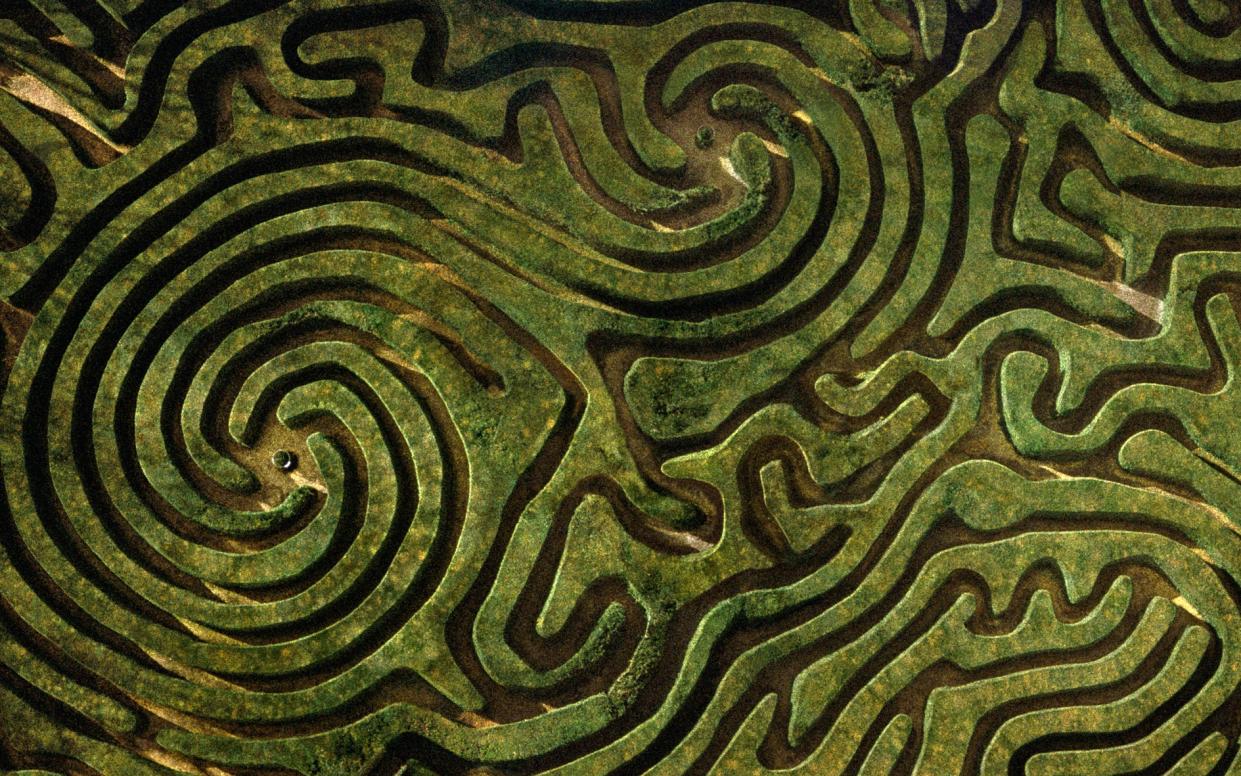
You cannot see the Yew Maze at Hever Castle from Anne Boleyn’s bedroom. The small space where Henry VIII’s second wife spent her childhood is at the north-west corner of the building, out of sight of the box of hedges and leafy pathways that sets a pleasing test for modern visitors to her family home. Instead, this genteel puzzle keeps its counsel on the other side of the honey-hued structure, by the main doorway and the little drawbridge.
It is a fine setting. For if an English country garden is the ideal context for an autumn day, a maze is the cream to the inevitable afternoon tea – as Jeremy Hunt demonstrated recently by entertaining fellow European foreign ministers in the maze at his Chevening country retreat. A maze is a dose of unpretentious fun – that maddening sensation of hitting a dead-end; your wry smile as, on retracing your steps, you re-encounter fellow explorers and tacitly admit your error; the thrill of gaining the centre. And Hever captures the joy wonderfully, its maze placed not just next to one of England’s prettiest castles, but also alongside a lake that shows rural Kent an image of itself in the October light.
And yet, as I amble the gravel corridors between the walls of manicured shrubbery, I find myself drawn away from the simplicity of the pleasure, my mind entertaining the notion that one of Britain’s most doomed romantic figures is watching. Not watching me, per se, but an echo version of her younger self – breathing excitedly, being chased in wolfish fashion by the monarch who would make her his queen at vast political and personal cost.

It is not so odd a vision. We are almost at the 500th anniversary of the passion play that saw the King of England pursuing the object of his obsession so fervently that he was prepared to sever his country’s relations with the Pope to marry her – and bring the ire of Spain and France on to his realm in the process. Almost, but not quite. An exact half-millennium ago, in 1518, Anne Boleyn was on the other side of the Channel, ensconced in the household of the French queen as a maid of honour; Henry was still stuttering through his marriage to Catherine of Aragon, seeking his male heir. It would be another seven years before Anne, now one of Catherine’s ladies-in-waiting, would catch Henry’s gaze, and a duel of flirtation would begin. The king was a regular guest at Hever, dashing to Kent to woo a shrewd woman who – having seen how he had seduced then spurned her older sister Mary – refused to be his mistress. Rather, she led him through an emotional maze of beck and call, resisting him for a reputed seven years before finally consenting. When they married in January 1533 she was pregnant (with the future Elizabeth I).
Neither of the lovebirds would have entered this maze, of course. While Henry stayed at Hever regularly in the late 1520s (one of the weighty brass locks that his retinue carried, used to seal his bed-chamber against the threat of assassination, remains at the castle), the labyrinth in its grounds is a 20th-century creation. Mazes would not have been alien to 16th-century eyes – they had existed in pharaonic Egypt and ancient Greece – and they were certainly not out of kilter with the pageantry that characterised the first decade (in particular) of Henry’s reign. But the Hever version was not planted until 1903, when the property came under the new, invigorating ownership of the US businessman William Waldorf Astor. It is a piece of Belle époque whimsy – and as I continue to stroll in and out of cul-de-sacs (investigating one of them twice), I can also imagine the merriment of parties in the sunny decade before the First World War, parasols bobbing between the hedgerows. I am still picturing this scene when I realise I have stumbled into the middle – where there is an ornamental obelisk, and a hand-bell to declare your success to anybody coming in your wake. I give it a good shake.

Hever is not the only historic site with a maze (see below), but it is rare in having two. Its second is a “water maze”, where concentric circles of paving slabs have been laid in a pond. The idea is to reach a squat tower at its heart, without getting wet. It looks easy. It proves fiendish. There is but one correct route. Each other way is blocked by false stones that tilt under the full pressure of a foot, triggering hidden fountains that soak the hapless adventurer. In truth, it is more Crystal Maze than Edwardian frippery, let alone Tudor relic. But it feels like a metaphor. Again, Anne Boleyn slips into my vision – only now in 1536, dead to Henry’s affections, hemmed in by charges of adultery and treason that would drag her to the execution block, her every possible move a wrong turn. It is a dark thought; too dark for a crisp autumn day. So once I have finally made it to the tower, dishevelled and damp, having been blasted twice, I head back towards the castle in search of cake and coffee, padding past the yew maze, where laughter still chimes within.
10 marvellous mazes
Hampton Court
As with Hever, Henry VIII did not wander the maze at Hampton Court – even though he lived in this palace (hrp.org.uk/hampton-court-palace; £19.20) on the Thames at Kingston on and off between 1529 and 1547. But another king did. It was planted between 1689 and 1695 as part of William III’s renovation of the property. It is one of the highlights of gardens that spread out to 60 acres – and is commended for its complexity.
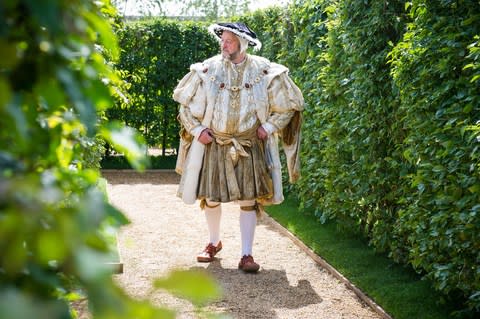
Leeds Castle
Leeds Castle (leeds-castle.com; £25.50) plays a similar card to Hever, splicing a grand slab of centuries-old Kent masonry (Norman in origin, founded in 1086) to a tranche of confusing topiary. Its maze comprises 2,400 yew trees – and when viewed from above, resembles a crown. The end-game is an eerie underground grotto – decorated with faces of mythical beasts, made of seashells.
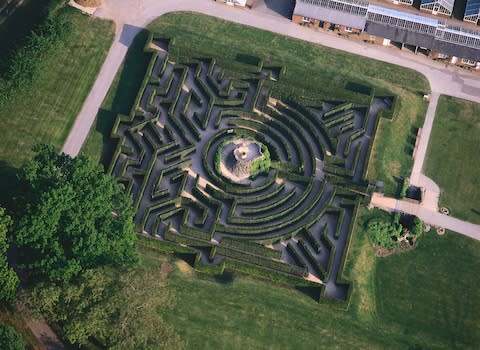
Longleat
The Wiltshire stately home-cum-safari park (longleat.co.uk; from £29.70) has big words for its maze (pictured top). It claims that, built using 16,000 yew trees, it is the largest in Britain – and that it is capable of detaining you for up to 90 minutes, depending on your puzzle-solving skills. Imminent visits can be combined with Longleat’s annual Festival of Light (Nov 9-Jan 6), where a barrage of Chinese lanterns will illuminate the grounds.
Castlewellan Forest Park
This rustic enclave, close to the village of Castlewellan in County Down, contains what it describes, simply, as a “permanent hedge maze [which represents] the path to a peaceful future for Northern Ireland”. It was planted by local communities in 2000, shortly after the Good Friday Agreement became effective. It covers 2.7 acres and has a “peace bell”, which waits to be rung at its centre (see nidirect.gov.uk/articles/castlewellan-forest-park).

The Forbidden Corner
There is an air of mystery to this web of tunnels and hidden chambers, which lights up Tupgill Park, near Agglethorpe in the Yorkshire Dales (theforbiddencorner.co.uk; £12.50; booking required). It was built as a private folly but, since being opened to the public, it has echoed to the sound of children racing through underworld temples, secret passages and translucent pyramids. A “Hallowe’en Week” is scheduled for Oct 27-Nov 4.
Traquair House
One of the most stately sights in the Scottish Borders, Traquair House (traquair.co.uk; £9) has held its ground near Peebles, in various forms, for more than 900 years. Its maze is a more recent addition, created in 1981 using 1,500 leylandii (and planted anew using more solid beech trees once the harsh winter of 1983 had undone all this hard work). It is the scene of a popular egg hunt (6,000 chunks of chocolate hidden within) on Easter Sunday.
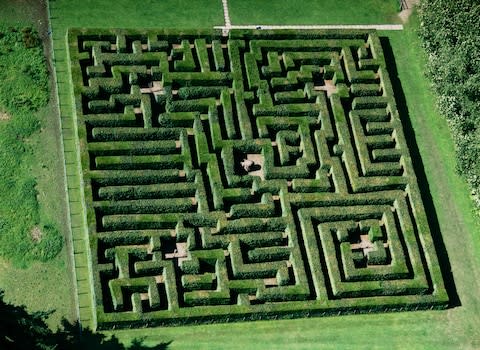
Alnwick Castle
The seat of the Duke of Northumberland – another formidable remnant of Norman times (alnwickcastle.com; from £14.40) – has taken a different approach to the concept of a maze on the lawn. Its grounds, once landscaped by Lancelot “Capability” Brown, include a modern formal garden, opened in 2001. It features curiosities such as a “Poison Garden” of toxic plants, and a “Bamboo Labyrinth”.
Schoenbrunn Palace (Austria)
The maze has also made its way to Vienna, and the former summer residence of Austro-Hungarian royalty (schoenbrunn.at; from €14.20/£12.50). The elaborate gardens are arguably the most special element of Schoenbrunn Palace, and its maze – first laid out in 1720, rebuilt in 1999 – sits perfectly within them. It is more than a cube of sculpted yew; extras inside include maths riddles and climbing poles. Three nights at the five-star Hotel Imperial cost from £1,048 a head with flights, via Kirker Holidays (020 7593 1899; kirkerholidays.com).
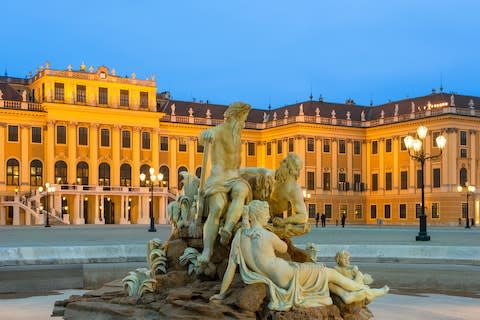
Dole Plantation (USA)
There are competing arguments as to what constitutes the world’s largest maze. There are claims for the vast Yancheng Dafeng Dream Maze, near Shanghai – and for the Pineapple Garden Maze, at Dole Plantation, on the Hawaiian island of Oahu (doleplantation.com; US$8/£6). Some 14,000 plants shape this three-acre challenge (including the pineapple at its heart). A week’s stay at the four-star Hilton Waikiki Beach, flying from Heathrow on Nov 24, costs £1,881 a head via Virgin Holidays (0344 739 6831; virginholidays.co.uk).
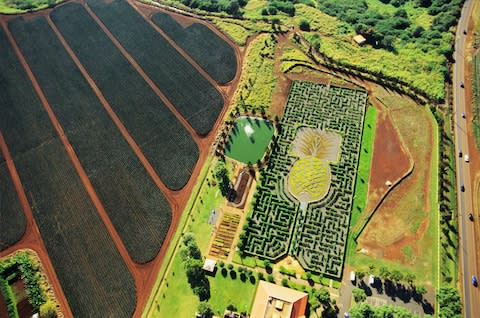
Labyrinth Park (Greece)
What of mythology’s most feted maze, the labyrinth that held the notorious Minotaur at the court of King Minos of Crete? The roots of the legend lie on the biggest of the Greek islands – at the remains of Knossos (odysseus.culture.gr; €15) and at sister archaeological site Gortyn (see explorecrete.com; €6). You will not spot a man-bull at either – although you can at least find a maze at Labyrinth Park, a family-friendly attraction near Heraklion (labyrinthpark.gr; €10). Seven nights at the Blue Palace Resort, near Elounda, flying from Manchester on April 21, are £2,436 a head via Sovereign (01293 839588; sovereign.com).


